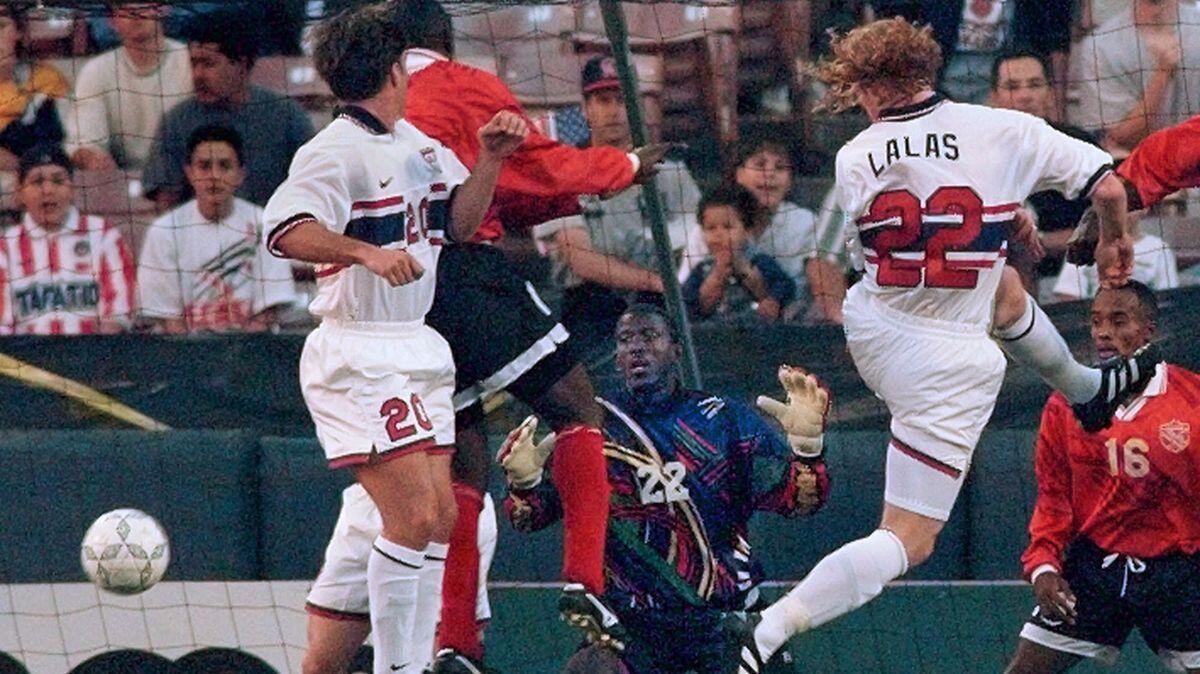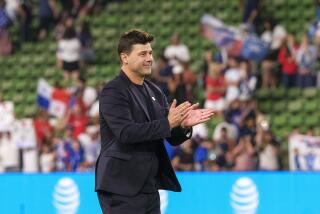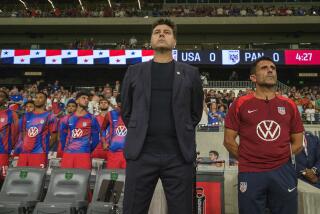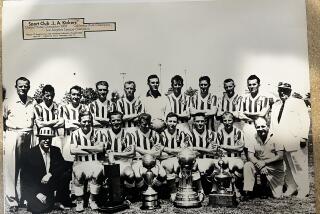World Cup team ‘changed the game forever’ for U.S.
- Share via
Reporting from ORLANDO, Fla. — Brian Bliss remembers coming off the field after the game that changed everything, believing nothing really was different.
Perhaps it was the fatigue of playing 90 minutes on a stiflingly humid day in Trinidad. Or the shock of the 1-0 win that had qualified the U.S. soccer team for a World Cup for the first time in four decades.
Either way, the future wasn’t clear to Bliss or his teammates on that autumn day in 1989.
“We just took it as the moment,” he said this week, looking back instead of forward. “We didn’t know how much the game was going to grow in the U.S. We thought, ‘Who knows when the next [World Cup] will be?’ ”
Yet in the span of one generation, that result has transformed men’s soccer in the U.S. from a game played largely by amateurs and college players to one with two thriving professional leagues. Its national federation went from broke to flush and the soccer industry nationwide expanded from a niche business to a multibillion-dollar enterprise, fueled by a boom that has seen more kids join organized leagues in the U.S. than in any country other than China.
The most profound change, though, was a mental one. Because before that game, imagining the U.S. in a World Cup was a little like imagining a donkey running in the Kentucky Derby: Impossible.
Now it’s hard to imagine a World Cup without the U.S., one of only seven countries to play in the last seven tournaments.
And it all began with the looping, left-footed shot from Paul Caligiuri that beat Trinidad and Tobago and sent the American team to its first World Cup since 1950.
“We changed the game forever in the United States,” Caligiuri said. “In a positive way. We built this game.”
Now that foundation is in danger of cracking. For the first time since Caligiuri’s goal, the U.S. will enter its final two qualifiers with its future in doubt. Without wins over Panama on Friday and Trinidad and Tobago next week, the U.S. could miss the next World Cup, something 16 players on this year’s national team have never been alive to see.

“We have a generation that expects us to go to every single World Cup. And that’s the consternation right now,” said Alexi Lalas, a former national team defender and now an analyst for Fox Sports. “We find ourselves in a seemingly unfamiliar place.”
Yet that’s the place where Caligiuri spent most of his life. Growing up in Diamond Bar at a time when soccer was as foreign as cricket or curling, Caligiuri practiced alone, booting a ball against a garage door.
“I lived in the era where it wasn’t realistic to think, ‘Oh, we can make to the World Cup,’ ” he said.
At UCLA, he led the Bruins — and coach Sigi Schmid — to their first national title before joining the semi-pro San Diego Nomads. He also moonlighted with the national team, which typically played at small stadiums before even smaller crowds.
“We were making like $25 a day per diem, just to stay alive,” he said. “But all that adds fuel to the fire. It feeds your desire to be successful.”
When Caligiuri joined the national team, the U.S. had never had a winning record in a year in which it played more than two games. Four years later it took part in the Olympic tournament for just the third time since 1956. And though the Americans didn’t win a game, they won some confidence.
“That kind of gave us a platform, that group of guys, to continue to play for our national team. And helped us grow to help us qualify for the [World] Cup,” Bliss said by phone from Kansas, where he serves as director of player personnel for Sporting Kansas City of MLS.
“I wouldn’t say that anybody was really thinking so much about not doing it for 40 years. What guys were saying [was], ‘Hey, we qualified for the Olympics. We can do this because we just did something similar. ‘ ”
Caligiuri agrees. But he remembers there was something else weighing on the team that made their qualifying campaign even more important.
Although the U.S. had been awarded the rights to host the 1994 World Cup, pressure was building to rescind that offer. The U.S. had no soccer tradition, no success in the sport and, some worried, no interest in it, either. The thought of empty stadiums kept FIFA officials up at night.
“It seems to us that in the event we didn’t qualify for the World Cup, we wouldn’t be hosting the World Cup,” Caligiuri said. “That gave us an extra incentive.”
Going into the final match, Trinidad and Tobago needed only a draw to eliminate the U.S., which needed a win to advance. A couple of nights before the game, Caligiuri said he dreamt of scoring a goal and of goalkeeper Tony Meola posting a shutout in 1-0 win.
Coming into that year Caligiuri had one international goal and Meola had started one national team game. Yet against tremendous odds, that dream came true and seven months later the underdog Americans got a standing ovation in Rome after a 1-0 loss to Italy.
“We got world respect that day,” said Caligiuri, who coaches an Orange County team that plays in the fourth-division National Premier Soccer League. “It’s in Rome against Italy at the World Cup. No bigger stage.
“I believe that’s the day we were accepted into the global game.”
Five days later, the Americans played Austria before a crowd that included a young fan named Alexi Lalas. Four years later Lalas would start four games for the U.S., in the U.S., in the best-attended World Cup of all-time.
“There’s no question that that started to open the door and started to expose us to the rest of the world,” said Tab Ramos, who set up Caligiuri’s iconic goal and went on to make three World Cup rosters. “We’re a soccer nation now. And we’re expected to qualify.”
“But we still have a lot of work to do,” added Ramos, U.S. Soccer’s youth technical director and U-20 national team coach. “If for some reason this time or next time of two World Cups from now we didn’t qualify, it would certainly slow down the process.
“Then everybody would go back to work and continue to do what we’re doing to advance the game. That’s the way it works.”
Follow Kevin Baxter on Twitter @kbaxter11







